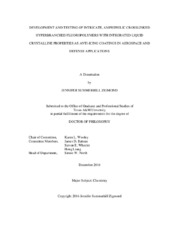| dc.description.abstract | Atmospheric icing, the process by which supercooled water droplets freeze upon contact with a surface, has proven to be devasting when not controlled or prevented. Currently, the solution for addressing this problem is the use of deicing fluids, which are toxic and inefficient, leading to the development of intrinsically anti-icing materials to focus on prevention rather than response after manifestation. Amphiphilic polymer coatings have been of particular interest as they are capable of presenting complex nano- and microscopic heterogeneities for inhibition of ice formation, which is not a typical approach toward anti-icing technologies. We have previously synthesized crosslinked networks comprised of hyperbranched fluoropolymers (HBFP) and poly(ethylene glycol) (PEG), which demonstrated superb anti-biofouling capabilities credited to their amphiphilic morphology, nanoscopic surface topography and dynamic surface reorganization. Through the tuning of the amphiphilicity and thermo-responsive molecular ordering of this crosslinked hyperbranched network, we expand the application of these materials by exploiting their characteristics for development of robust, dynamic, anti-icing coatings for aerospace applications.
An array of films was synthesized by varying the PEG crosslinker to study the effect of hydrophilic:hydrophobic component ratios on the thermal, mechanical and surface properties. Differential scanning calorimetry (DSC) data show significant reductions in the water melting transition temperatures (-5 ⁰C and -27 ⁰C for free and bound water, respectively). The novel application of this system displays the expansion and diversity of a well-established coating that demonstrates unique water confinement and sequestration behaviors with the ability to reorganize at the surface. Due to its great potential as an anti-icing coating, additional investigations and chemical manipulation of the binary system led to the integration of a thermally-dynamic molecule, a liquid crystalline (LC) moiety. A library of LC systems was developed in order to probe the effects that size, mesophase and topology would have on the water depression efficiency of these materials. An LC monomer was incorporated into the polymer during polymerization in order to enhance the dynamic reorganization of the system during changes in temperature and wetting. The results suggest that the unique LC-HBFP system is a viable option as a dynamic coating for extreme environments. | en |


